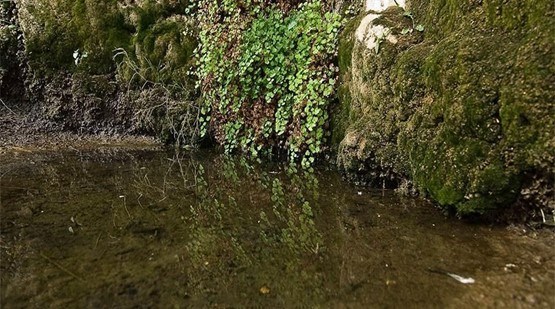Part of a series of articles titled Condition of Selected Natural Resources at Mesa Verde National Park: A 2025 Assessment.
Article
What do we Know about the Condition of Springs and Seeps at Mesa Verde National Park?
A 2025 Natural Resource Condition Assessment evaluated six natural resources at Mesa Verde National Park. This article describes what we learned about the condition of springs and seeps.

NPS
Springs and Seeps was one of six resources included in the 2025 Natural Resource Condition Assessment (NRCA) for Mesa Verde National Park (NP). NRCAs provide a scientifically based update on current resource conditions for a subset of park natural resources. They also identify resource stressors and gaps in our knowledge. The NRCA team, led by Conservation Science Partners, examined springs and seeps by conducting a gap analysis. A gap analysis highlights what we know and don’t know about a resource, while a condition assessment is a more thorough evaluation of a resource’s current condition. Data availability determines which type of study researchers conduct. An overview article describes the intent of the NRCA project and the other resources assessed for Mesa Verde NP.
Springs in Mesa Verde are fed by the park’s aquifers. Park springs are typically small, with average flow (the volume of water passing a certain point at a certain time) less than 0.8 cups (0.2 liters) per second. All springs in the park are cool-water springs, with average water temperatures of about 55 degrees Fahrenheit (13 degrees Celsius). While plants that occur at some Mesa Verde springs are relatively common, others, such as in hanging gardens, are regionally rare.
Springs, seeps, and hanging gardens provide essential water and wildlife habitat. They are important oases of biodiversity in desert landscapes. For example, many of Mesa Verde’s common bird and mammal species have been found at its springs. These include top predators such as peregrine falcons (Falco peregrinus), golden eagles (Aquila chrysaetos), bobcats (Lynx rufus), and American black bears (Ursus americanus). Although only a few of the park’s springs have been inventoried thoroughly, they are clearly valuable habitats that support unique and high concentrations of Mesa Verde’s plants and animals.
In general, these features are sensitive to a variety of human activities and disturbances. These include groundwater diversion, livestock grazing, and recreation, as well as climate change. A large number of non-native plant species also occur in and around springs in Mesa Verde.
How did the NRCA team conduct the gap analysis?
For the springs and seeps gap analysis, the NRCA team used a long-term dataset from the park that contained information on 265 springs and seeps within or near Mesa Verde. The team looked at four different aspects of springs and seeps:
- the average annual spring-season flow rates (in liters per second),
- the average annual pool volumes (meaning the dimensions of a spring pool, in meters cubed),
- the number of springs that were within 10 meters (33 feet) of a road or hiking trail, and
- the degree to which feral livestock were present at park springs and seeps.
What did the NRCA team find?
No Clear Trend in Flow Rates and Pool Volumes
The NRCA team found that while there was large year-to-year variation in spring-season flow and pool volume from 1984 to 2023, there was not a clear trend for either measure. However, spring flow did decrease at some springs.
Only 4% of Springs Near a Road or Trail
The NRCA team found that only 11 of the 265 springs (~4%) were within 10 meters (33 feet) of a main road, backcountry road, or hiking trail. Ten meters represents the smallest distance required to protect springs—especially their water quality—from human disturbance (Clinton 2011, Parkyn 2004).
Presence of Feral Livestock at 4 of 27 Springs
Out of 27 seeps/springs that were monitored within five years leading up to the NRCA project, four (15%) had a documented trespass of a horse or cow. Even occasional grazing or trampling of plants and spring/seep edges can impact plants and increase cloudiness of the water.
What can park managers do with this information?
Information from the gap analysis will help guide planning, stewardship, and management for these important resources in the park. Based on the limited information available, the NRCA team made a few monitoring and management recommendations. For example, because not every spring in the park can be assessed every year, the team suggested that park managers visit, every second or third year, the majority of those springs known to be flowing. This would enable a more thorough understanding of how springs and seeps are doing at Mesa Verde.
References
Clinton, B. D. 2011. Stream water responses to timber harvest: Riparian buffer width effectiveness. Forest Ecology and Management 261(6):979–988. Available at https://doi.org/10.1016/j.foreco.2010.12.012.
Parkyn, S. 2004. Review of riparian buffer zone effectiveness. Ministry of Agriculture and Forestry (MAF) Technical Paper No: 2004/05. Available at https://www.gw.govt.nz/assets/Documents/2022/05/10.1.1.74.742.pdf.
Last updated: June 25, 2025
